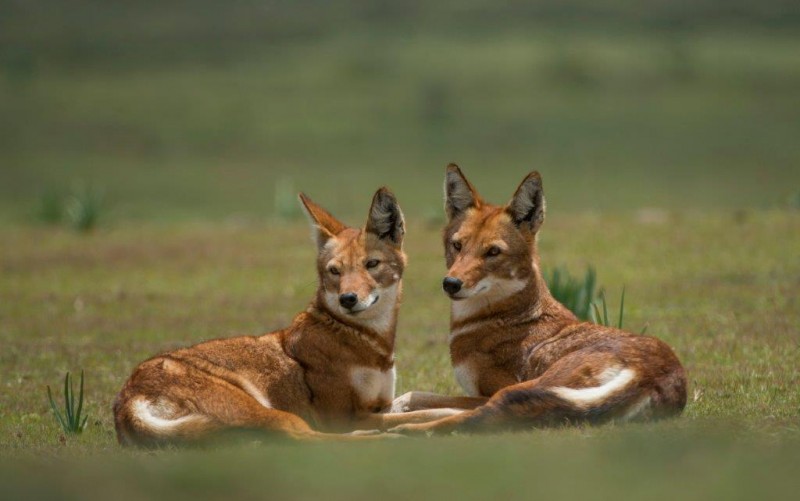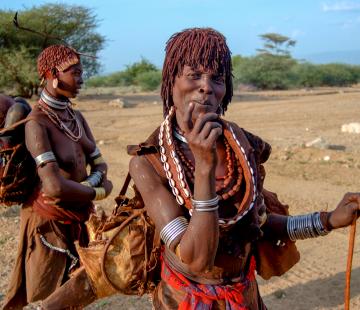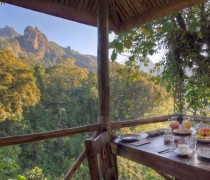Travel With Tamara | Saving the Wolves in Ethiopia
Saving the Wolves in Ethiopia
Ethiopian wolves are the most endangered canid in the world, so I was delighted to have the chance to interview Neville Slade about his work on their protection.

What brought Frankfurt Zoological Society to Bale Mountains National Park?
We came to protect the Ethiopian Wolf; that was 12 years ago. The wolf is the most endangered carnivore in Africa and the most endangered canid in the world. At the time, there were about 600 left worldwide. Then rabies and distemper depleted their numbers further. There are now about 350, of which 70% are in the Bale Mountains. The Frankfurt Zoological Society helps protect the environments of animals threatened with extinction, so this was a key place for them to be.
How can you protect a species like that?
We work with the Ethiopian Wildlife Conservation Authority. Because of the reputation FZS has of being a capable conservation society, we can attract funding, so we have the ability to implement projects. And of course, it’s not only about the wolves. Everything affects everything else and we need to protect the whole thing – the environment and all the other species – and we have to work with the local people to make this happen. We look at the long-term and implement long-term projects.
This is a unique environment. Much of the park is over 4,000m altitude and is one of Africa’s vital water towers. Four major rivers run off it onto the plains, supplying 20 million people between the Bale Mountains and the Somali Coast. We need to preserve the very top of this chain. If you destroy the vegetation at the top, when it rains, all the water will run off it or evaporate. We have four distinct eco-systems in one park – rainforest, alpine plateau, juniper forest and sub-alpine forest – and all are key. As well as high numbers of endemic plants, the park has important flora such as wild forest coffee and several vital medicinal plants.
High numbers of Ethiopia’s endemic species are found here, including the Bale monkey, mountain nyala and giant mole rat. There are also endangered species such as wild dog, melanistic leopard and harenna lion. There are 320 species of birds here, including 170 migratory species and 14 endemic species; wattled cranes and lots of vultures and eagles have been recorded here. It’s claimed that if conservation efforts here aren’t successful, more species of mammal would go extinct than in any other similarly sized area the world over. But the population of Ethiopia is now around 100 million, and is expected to rise to 130 million within the next 30 years. Between six and eight thousand people live in the park, and many more around it, and they continue to exploit the land unsustainably, planting their crops and grazing their wildlife indiscriminately. In Africa it’s all about politics and people – animals don’t have a vote.
So what can you do?
Last year, I took 15 Ethiopian government ministers to Kenya to look at the conservation areas there. They met people working in conservation including the Kenya Wildlife Service, and Richard Leakey. By the end of that eight-day trip they could see the value of conservation; they saw the way it works in Kenya, and how it could work in Ethiopia. They returned to Ethiopia with new enthusiasm; a general management strategy has now been ratified that includes the plan to move all the people out of the parks within the next 10 or 15 years. They also realised the protection of the water tower is vital, not just for the wolf, but for the 20 million people downstream. But there’s a lot of work to be done.
How does tourism affect conservation?
Tourism, done the right way, is of huge benefit to conservation. We get around 8,000 tourists per year in Bale Mountains National Park, and of those, about 2,000 go hiking. The park has an area of about 2,150km2 but there’s only one road through it so only around 8% of the park can be seen from a vehicle. The remaining 92% can only be seen on foot or from the back of a horse. We have a Porters Association, a Guiding Association, and a Cooks Association; all these not only enhance the tourists’ experience, helping them get away from the road and explore large tracks of the park, but also provide employment for locals.
But entrance fees for national parks here are around 4 USD per day, whereas in Kenya they’re about 70 USD, so it’s difficult to sustain tourism areas. National parks in Ethiopia need partners to fund and manage them. Education and capacity building of local government is also important. Seeing is believing. They need to see what’s possible. It makes much more sense when they’ve experienced it.
Now Ethiopia has declared a state of emergency. This has a direct affect on tourism bookings and on our revenue. And when there are fewer tourists, we get increased pressure from people bringing their livestock into the park.
How did you get into this line of work?
I grew up in Kenya, living with the Maasai. My father was involved in the establishment of Olkirimatian Conservancy, near Magadi. Conservation was a part of my life from a very young age, and I lived and breathed it. Later, I spent 15 years in Mozambique doing forestry and livelihood schemes, always with an eye on conservation. When the opportunity came up to work with FZS in Ethiopia, I took it. I’ve been here for three and a half years now. As long as the project is viable and there’s interest in it, I’m keen to be here. Who knows how long that will be.
What’s in a day for you?
Every day’s different, with different challenges. This is general management, and all the experience we at FZS have comes into play. We have 82 scouts, 50 horses and eight vehicles, and everything has to be managed. Recently some cattle entered the park illegally and were confiscated, and the locals retaliated. That needed to be resolved sensitively. We work with the communities to try to improve their livelihoods, and try to reduce the numbers of cattle and encourage different kinds of crops. We also try to encourage tourism as it brings income that can help our conservation efforts. I work very long days as I live on the job. What happens today directly affects tomorrow. It’s hands on all the time.
Tamara Britten, 04 May 2020
Published also in: Nomad Magazine
About the region
Southern

Ethiopia’s south is perhaps best known for the tribes who dwell here, particularly around the Omo Valley, who live according to their traditional customs. The region is also known for the Bale Mountains National Park, and for the chain of lakes that stud the Rift Valley.
Read more about SouthernWhere to stay
The rolling hills and craggy peaks of Bale Mountain National Park are filled with 87 mammal species including the rare Abyssinian Wolf and the Mountain Nyala. Bale Mountain is home to 320 species of birds including 170 migratory birds and 14 endemic species. Bale Mountain Lodge has breath-taking views ...
